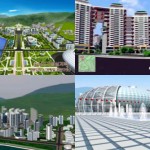Michael Rank
North Korean officials have claimed that there are 500 “house churches” where Christians can worship in a country that has been widely accused of ruthlessly persecuting believers, sometimes to death.
Two British parliamentarians who visited North Korea late last month quote officials of the Korean Christian Federation as making the claim, although they note that “other sources question this and we were unable to verify these figures.”
At Bongsu Protestant church in Pyongyang (satellite image here) they were told that 20,000 Bibles and hymnals had been printed and that there were 13,000 Protestants in North Korea.
Lord Alton and Baroness Cox visited a new Protestant seminary in Pyongyang with 12 students and 10 teachers, as well as Catholic and Russian Orthodox churches in the capital.
In their report, Building Bridges, Not Walls they describe how seminary students “pursue a five-year course and are then admitted to the Korean Christian Fellowship as pastors upon graduation.”
“The Protestant church expressed a desire to establish links with Protestant, particularly Presbyterian, churches in the UK, and appears to receive support from Korean-American Christians in some parts of the United States.”
Alton and Cox, both devout Christians, said North Korean officials had reiterated an invitation for the Archbishop of Canterbury, Dr Rowan Williams, to visit Pyongyang. The invitation was first extended by the speaker of the Supreme People’s Assembly, Choe Tae-bok, when he visited Williams at Lambeth Palace in London in 2004 and whom Alton and Cox met again last month.
The invitation seems to have caused some embarrassment to the archbishop. A spokeswoman for Dr Williams told NKEW she had no knowledge of it and failed to respond when asked to check further into the matter.
Alton and Cox, who were paying their third visit to Pyongyang, said Choe had accepted an invitation to visit Britain again next year.
The group also visited the Supreme Court, where “it was evident that the defendant in a trial is already deemed a suspect, as reflected in the structure of the courtroom in which the defendant is placed in small, wooden enclosure, seated on a small, very uncomfortable stool, in contrast to more comfortable chairs for others.
“The Senior Law Officer confirmed to us that the principle of innocent until proven guilty does not apply in the North Korean judicial system.
“‘Most defendants are those whose crime has already been revealed, before indictment, by investigation by the police. When a person comes to court, we do not think of them as innocent,’ he said.
“Furthermore, it appears that the legal defence available for the defendant would only become actively involved in the process once the ‘suspect’ is brought to trial and all the relevant evidence has been prepared.
“We would urge the DPRK authorities to ensure that the accused receives legal assistance before the trial stage,” Alton and Cox say in their report.
They frequently asked whether they, or any foreigners, could visit a prison, including the notorious Yodok prison camp, and were told emphatically “no”.
Alton and Cox also discussed security issues with North Korean officials, including Vice Minister for Foreign Affairs Kung Sok-ung.
who told them that his government’s position on peace and security “remains unchanged – to settle the issues through negotiation and dialogue, and to secure stability through peaceful means.”
There do seem to be signs of internal change, however. Senior North Korean officials told the group that the country is entering a period of “momentous change”, and the report notes that “It is also interesting that the emphasis in North Korea has changed, from a focus on its ‘Songun’ or ‘military first’ policy, to a new objective of establishing a ‘great, prosperous and powerful nation’ by 2012.
“This was set out in a communiqué by the Workers’ Party of Korea on 11 October, marking its sixty-fifth anniversary, in which it spoke of building a ‘dignified and prosperous’ nation.
“This change of emphasis is very welcome, and presents the international community with another important opportunity.”
“We believe the time has come for North and South Korea and the United States, with assistance from others in the international community including the United Kingdom (as a former combatant nation which saw 1,000 of its servicemen lose their lives in the Korean War), a neutral country such as Switzerland or Sweden (who were among the countries given responsibility in 1953 to oversee the armistice), and, above all, China, to work to find ways to turn the armistice into a permanent peace.
“A Beijing Peace Conference at which North and South could resolve their differences should be convened once the necessary preliminary brokering has been completed.
“We also believe grave human rights concerns should be discussed through a process of dialogue and constructive, critical engagement, in parallel with a resumption of the Six-Party Talks concerning security, in the same way as the Helsinki Process was established by President Ronald Reagan and Margaret Thatcher with the Soviet Union. It is time for peace, and it is time for Helsinki with a Korean face”.
They add that “DPRK officials made it clear that a permanent peace, and reunification of Korea, is their priority, and they emphasised their commitment to negotiating a peaceful resolution through dialogue.”
For an interview with Baroness Cox after her previous visit to Pyongyang in 2009 click here.

